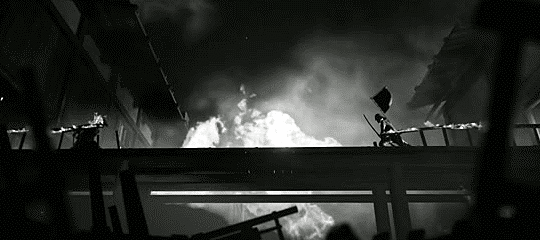It’s high time to circle back from my Trek to Yomi preview from March and take on the full game. I was dazzled by the title’s idyllic presentation of feudal Japan in film-noir black-and-white, supplemented by tight combat where mistakes were punished and courage led to pulling through. At the time, I wasn’t sure when the full game would be released, but the preview’s cliffhanger had me on the edge of my seat aching for more – now that the game’s out, how does it fare?

Story
Trek to Yomi is a tale of duty, courage, and persistence, but also one of torment, dread, and hopelessness. A tragedy befalls protagonist Hiroki, one so great that he is plagued with regret and must face the consequences of his actions as he journeys into Yomi, the Japanese land of the dead. Think of it as the American “Highway to Hell” or a Nordic “Odyssey to Nilfheim“. It’s engaging all the way through, and even incorporates some varied decisions as to exactly why Hiroki must keep going, what keeps him motivated on his Trek and what his revenge earns him. As Trek to Yomi stretches around 5 hours in length, its story can be absorbed in about two sittings.

Your journey to the afterlife will still threaten your existence, your purpose, or the one you love.
Gameplay
While I got my feel for the combat in the preview of Trek to Yomi, I noticed several Steam reviews mention that it’s “unresponsive” or “janky“, which simply isn’t the truth. Throughout my entire playthrough, every input matched the action I wanted to carry out, whether it was using one of the game’s many unlockable sword combos or the risk/reward projectiles. If I was too early/late, it was properly punished with some damage, and I would adjust my playstyle accordingly. More difficult enemies later on demanded more attention, all while juggling the stamina bar so I wouldn’t lose my ability to block/parry.
The combat, once mastered, flows seamlessly and keeps you on your toes, especially in the harder difficulties where one mistake meets your end. My only complaint is that enemies got a little too predictable after learning their patterns – nothing more than a nitpick in the grand scheme.
Audio
One of the highest praises I gave the preview of Trek to Yomi was its audio design. The anguish in the voices of pillaged villagers had me hyper-immersed at every turn, instilling a sense of duty in my actions. Similarly, felling a foe results in sharp pain-riddled screams, typically dispatched within one or two swings. Watching homes fall feels devastating as each inch crumbles down into your eardrums. As for the soundtrack, the 53 separate tracks are available to not only stream, but purchase, as of now.
Visuals
The eye-grabber in Trek to Yomi is most abundantly its black-and-white presentation. There’s no other colors within the entirety of the game – a testament that dedicating to a style this vehemently can indeed be pulled off. Progressing through levels takes on a 2.5D side-scroll where no two screens have the same curvature – the fascinating environments may provoke one to stop and stare in-between the frenetic fighting. This is helped by the silky-smooth framerate that doesn’t even drop as buildings fall and several enemies pile onto the screen. I’d love to flood this article with screenshots, but there’s just as much to talk about as there is to view, and I’ll leave the scenery as a surprise to those interested.

Fights can end in one swing in Trek to Yomi – so choose your inputs carefully!
So, why should you play it?
- You enjoy indie games with a unique presentation.
- You live for games with intense action where you can both kill or die in one hit.
- You want to have control of the narrative in the long run.
But why shouldn’t you play it?
- Five hours isn’t long enough of a game for you.
- You want varied/vibrant colors in your game.
A press copy of Trek to Yomi was provided courtesy of the publisher.
You can find out more about Trek to Yomi here.




